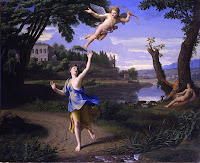I've become quite addicted to Once Upon a Time, the ABC show starring Ginnifer Goodwin and Jennifer Morrison (far less annoying than on House, by the way). I love the fantasy elements, and it made me curious about fairy tales in antiquity.
A bit of time with Google Scholar and this monograph have clarified a few things to me, which may be obvious to others:
1) Cinderella and Snow White are basically the same story. There are only so many ways your stepmother can mess with you. As Anderson points out in Fairytale in the Ancient World, "to anyone accustomed to reading folktales in quantity it will come as no surprise to encounter a male Cinderella, an angel as fairy godfather, a Cinderella without a slipper test, and many more such deviations." Female jealousy and infighting occur even now; they were perhaps even more common in an age of narrower female expectations and the frequent deaths of mothers and remarriage of fathers.
2) Happily ever after is an incredibly generous expectation and a modern luxury. The ancient fairy tale heroines Anderson proposes, such as Io and Psyche, make excessive housework and suspended animation seem like a vacation. Io, of course, hopes for nothing more than returning to human forms and living to bear Zeus' child. Hera inflicts household tasks of diabolical complexity on Psyche, such as sorting a enormous pile of mixed grains in a few hours' time and stealing beauty from the goddess of the underworld. It's a compelling story; if you're looking for a starter text for second year Latin, you might want to check out this simplified version.
I tend to be vaguely embarrassed at my romantic notions of the Middle Ages (fed by my historical fiction addiction), but at least in their imaginations medieval people tended to be more idealistic and more generous to their fictional heroes and heroines. I'm not sure whether we have cultural Christianity or Eleanor of Aquitaine's Court of Love to thank for that.

No comments:
Post a Comment